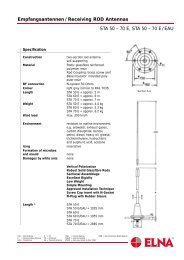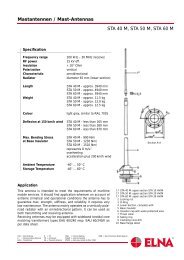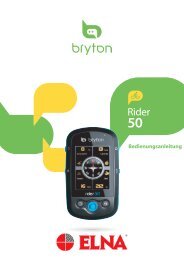Funkfeuerantennen / Radio Beacon Antenna STA 150 NDB (STA ...
Funkfeuerantennen / Radio Beacon Antenna STA 150 NDB (STA ...
Funkfeuerantennen / Radio Beacon Antenna STA 150 NDB (STA ...
Create successful ePaper yourself
Turn your PDF publications into a flip-book with our unique Google optimized e-Paper software.
<strong>Funkfeuerantennen</strong> / <strong>Radio</strong> <strong>Beacon</strong> <strong>Antenna</strong><br />
Lower Sections US 80 PM and US 80 PM/E (E for external)<br />
(or US 50 PM and US 50 PM/E)<br />
The lower section is a conical tubular mast with radiators embedded<br />
in the mast’s wall. The RF feed insulators, external and baseinjected<br />
ones, are carefully designed in order to avoid instable<br />
antenna impedances. The base-injection runs concentrically into<br />
the mast tube. It is held by small supports of good dielectric constant.<br />
On top of the lower section mast tube a joint armature carries the<br />
top load assembly. This joint fitting is connected to the embedded<br />
radiators and serves also as the electrical connection to the load<br />
assembly.<br />
The lower section mast tube stands on a cast aluminium base. This<br />
antenna base is fixed to tilting flanges or other stands by means of<br />
eight stainless steel bolts.<br />
The antenna can be fed either externally, injecting the mast from<br />
the side about 120 cm above the antenna base, or internally from<br />
the bottom through the antenna base (base injection).<br />
Base injected antennas permit direct installation above the radio<br />
room and the transmitter thus saving additional installation equipment<br />
(e.g. lead-through insulators, trunks, etc.) and providing a<br />
short way between transmitter and antenna input.<br />
Both antenna versions, the external and the base injected, can be<br />
installed on supports with appropriate tilting devices. Special attention<br />
has been paid to the watertight design of the base injected<br />
equipment.<br />
The internally fed arrangement offers not only the cheaper installation,<br />
but is also much more insensitive to the environment.<br />
Loading Coil Assembly<br />
The loading coil belongs to the top load assembly (picture 5) and is<br />
housed in a watertight construction (pos. 2). The air-core coil has a<br />
Q-factor of around 500. Spaced windings ensure excellent high<br />
voltage capability. The assembly has no inband resonance points.<br />
The standard loading coil is of quite small dimensions. It is 728 mm<br />
long and 126 mm in diameter only.<br />
(special coil versions may have deviating dimensions)<br />
The coil assembly is mounted on the lower mast section US 80 PM<br />
(or US 50 PM). The coil assembly bottom flange is fastened to a<br />
junction disk (pos. 7) by eight stainless steel hollow screws<br />
(pos. 10). The junction disk sits on the lower section joint armature<br />
(pos. l) fixed by a 46 mm retaining hex nut (pos. 5, tightening torque<br />
M = 180 Nm).<br />
ELNA reserves the right to make changes in specifications<br />
without notice.<br />
June 2000<br />
<strong>STA</strong> <strong>150</strong> <strong>NDB</strong> (<strong>STA</strong> 115 <strong>NDB</strong>)





